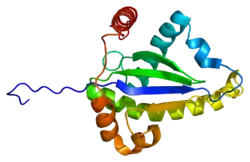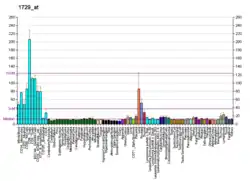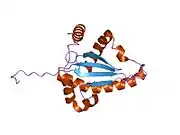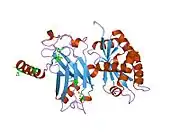TRADD
Tumor necrosis factor receptor type 1-associated DEATH domain protein is a protein that in humans is encoded by the TRADD gene.[4][5]
TRADD is an adaptor protein.
Function
The protein encoded by this gene is a death domain containing adaptor molecule that interacts with TNFRSF1A/TNFR1 and mediates programmed cell death signaling and NF-κB activation. This protein binds adaptor protein TRAF2, reduces the recruitment of inhibitor-of-apoptosis proteins (IAPs) by TRAF2, and thus suppresses TRAF2 mediated apoptosis. This protein can also interact with receptor TNFRSF6/FAS and adaptor protein FADD/MORT1, and is involved in the Fas-induced cell death pathway.[5]
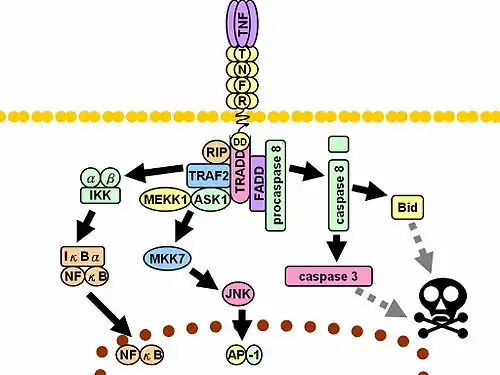
Signaling pathway of TNF-R1. Dashed grey lines represent multiple steps
Interactions
TRADD has been shown to interact with:
References
- GRCh38: Ensembl release 89: ENSG00000102871 - Ensembl, May 2017
- "Human PubMed Reference:". National Center for Biotechnology Information, U.S. National Library of Medicine.
- "Mouse PubMed Reference:". National Center for Biotechnology Information, U.S. National Library of Medicine.
- Hsu H, Xiong J, Goeddel DV (June 1995). "The TNF receptor 1-associated protein TRADD signals cell death and NF-kappa B activation". Cell. 81 (4): 495–504. doi:10.1016/0092-8674(95)90070-5. PMID 7758105. S2CID 14301562.
- "Entrez Gene: TRADD TNFRSF1A-associated via death domain".
- Hsu H, Shu HB, Pan MG, Goeddel DV (January 1996). "TRADD-TRAF2 and TRADD-FADD interactions define two distinct TNF receptor 1 signal transduction pathways". Cell. 84 (2): 299–308. doi:10.1016/s0092-8674(00)80984-8. PMID 8565075. S2CID 13171355.
- Henshall DC, Araki T, Schindler CK, Shinoda S, Lan JQ, Simon RP (September 2003). "Expression of death-associated protein kinase and recruitment to the tumor necrosis factor signaling pathway following brief seizures". J. Neurochem. 86 (5): 1260–70. doi:10.1046/j.1471-4159.2003.01934.x. PMID 12911633. S2CID 21971958.
- Thomas LR, Stillman DJ, Thorburn A (September 2002). "Regulation of Fas-associated death domain interactions by the death effector domain identified by a modified reverse two-hybrid screen". J. Biol. Chem. 277 (37): 34343–8. doi:10.1074/jbc.M204169200. PMID 12107169.
- Inada H, Izawa I, Nishizawa M, Fujita E, Kiyono T, Takahashi T, Momoi T, Inagaki M (October 2001). "Keratin attenuates tumor necrosis factor-induced cytotoxicity through association with TRADD". J. Cell Biol. 155 (3): 415–26. doi:10.1083/jcb.200103078. PMC 2150850. PMID 11684708.
- Hsu H, Huang J, Shu HB, Baichwal V, Goeddel DV (April 1996). "TNF-dependent recruitment of the protein kinase RIP to the TNF receptor-1 signaling complex". Immunity. 4 (4): 387–96. doi:10.1016/s1074-7613(00)80252-6. PMID 8612133.
- Wang Y, Wu TR, Cai S, Welte T, Chin YE (July 2000). "Stat1 as a component of tumor necrosis factor alpha receptor 1-TRADD signaling complex to inhibit NF-kappaB activation". Mol. Cell. Biol. 20 (13): 4505–12. doi:10.1128/mcb.20.13.4505-4512.2000. PMC 85828. PMID 10848577.
- Jiang Y, Woronicz JD, Liu W, Goeddel DV (January 1999). "Prevention of constitutive TNF receptor 1 signaling by silencer of death domains". Science. 283 (5401): 543–6. doi:10.1126/science.283.5401.543. PMID 9915703.
- Schütze S, Machleidt T, Adam D, Schwandner R, Wiegmann K, Kruse ML, Heinrich M, Wickel M, Krönke M (April 1999). "Inhibition of receptor internalization by monodansylcadaverine selectively blocks p55 tumor necrosis factor receptor death domain signaling". J. Biol. Chem. 274 (15): 10203–12. doi:10.1074/jbc.274.15.10203. PMID 10187805.
- Pan G, O'Rourke K, Chinnaiyan AM, Gentz R, Ebner R, Ni J, Dixit VM (April 1997). "The receptor for the cytotoxic ligand TRAIL". Science. 276 (5309): 111–3. doi:10.1126/science.276.5309.111. PMID 9082980. S2CID 19984057.
- Shu HB, Takeuchi M, Goeddel DV (November 1996). "The tumor necrosis factor receptor 2 signal transducers TRAF2 and c-IAP1 are components of the tumor necrosis factor receptor 1 signaling complex". Proc. Natl. Acad. Sci. U.S.A. 93 (24): 13973–8. doi:10.1073/pnas.93.24.13973. PMC 19479. PMID 8943045.
- Blankenship JW, Varfolomeev E, Goncharov T, Fedorova AV, Kirkpatrick DS, Izrael-Tomasevic A, Phu L, Arnott D, Aghajan M, Zobel K, Bazan JF, Fairbrother WJ, Deshayes K, Vucic D (January 2009). "Ubiquitin binding modulates IAP antagonist-stimulated proteasomal degradation of c-IAP1 and c-IAP2(1)". Biochem. J. 417 (1): 149–60. doi:10.1042/BJ20081885. PMID 18939944.
- Kitson J, Raven T, Jiang YP, Goeddel DV, Giles KM, Pun KT, Grinham CJ, Brown R, Farrow SN (November 1996). "A death-domain-containing receptor that mediates apoptosis". Nature. 384 (6607): 372–5. doi:10.1038/384372a0. PMID 8934525. S2CID 4283742.
- Bouwmeester T, Bauch A, Ruffner H, Angrand PO, Bergamini G, Croughton K, Cruciat C, Eberhard D, Gagneur J, Ghidelli S, Hopf C, Huhse B, Mangano R, Michon AM, Schirle M, Schlegl J, Schwab M, Stein MA, Bauer A, Casari G, Drewes G, Gavin AC, Jackson DB, Joberty G, Neubauer G, Rick J, Kuster B, Superti-Furga G (February 2004). "A physical and functional map of the human TNF-alpha/NF-kappa B signal transduction pathway". Nat. Cell Biol. 6 (2): 97–105. doi:10.1038/ncb1086. PMID 14743216. S2CID 11683986.
- Takeuchi M, Rothe M, Goeddel DV (August 1996). "Anatomy of TRAF2. Distinct domains for nuclear factor-kappaB activation and association with tumor necrosis factor signaling proteins". J. Biol. Chem. 271 (33): 19935–42. doi:10.1074/jbc.271.33.19935. PMID 8702708.
- Park YC, Ye H, Hsia C, Segal D, Rich RL, Liou HC, Myszka DG, Wu H (June 2000). "A novel mechanism of TRAF signaling revealed by structural and functional analyses of the TRADD-TRAF2 interaction". Cell. 101 (7): 777–87. doi:10.1016/s0092-8674(00)80889-2. PMID 10892748. S2CID 5928713.
- Tsao DH, McDonagh T, Telliez JB, Hsu S, Malakian K, Xu GY, Lin LL (June 2000). "Solution structure of N-TRADD and characterization of the interaction of N-TRADD and C-TRAF2, a key step in the TNFR1 signaling pathway". Mol. Cell. 5 (6): 1051–7. doi:10.1016/s1097-2765(00)80270-1. PMID 10911999.
- Tada K, Okazaki T, Sakon S, Kobarai T, Kurosawa K, Yamaoka S, Hashimoto H, Mak TW, Yagita H, Okumura K, Yeh WC, Nakano H (September 2001). "Critical roles of TRAF2 and TRAF5 in tumor necrosis factor-induced NF-kappa B activation and protection from cell death". J. Biol. Chem. 276 (39): 36530–4. doi:10.1074/jbc.M104837200. PMID 11479302.
- Malinin NL, Boldin MP, Kovalenko AV, Wallach D (February 1997). "MAP3K-related kinase involved in NF-kappaB induction by TNF, CD95 and IL-1". Nature. 385 (6616): 540–4. doi:10.1038/385540a0. PMID 9020361. S2CID 4366355.
Further reading
- Baker SJ, Reddy EP (1999). "Modulation of life and death by the TNF receptor superfamily". Oncogene. 17 (25): 3261–70. doi:10.1038/sj.onc.1202568. PMID 9916988.
- Hsu H, Shu HB, Pan MG, Goeddel DV (1996). "TRADD-TRAF2 and TRADD-FADD interactions define two distinct TNF receptor 1 signal transduction pathways". Cell. 84 (2): 299–308. doi:10.1016/S0092-8674(00)80984-8. PMID 8565075. S2CID 13171355.
- Hsu H, Huang J, Shu HB, Baichwal V, Goeddel DV (1996). "TNF-dependent recruitment of the protein kinase RIP to the TNF receptor-1 signaling complex". Immunity. 4 (4): 387–96. doi:10.1016/S1074-7613(00)80252-6. PMID 8612133.
- Boldin MP, Goncharov TM, Goltsev YV, Wallach D (1996). "Involvement of MACH, a novel MORT1/FADD-interacting protease, in Fas/APO-1- and TNF receptor-induced cell death". Cell. 85 (6): 803–15. doi:10.1016/S0092-8674(00)81265-9. PMID 8681376. S2CID 7415784.
- Takeuchi M, Rothe M, Goeddel DV (1996). "Anatomy of TRAF2. Distinct domains for nuclear factor-kappaB activation and association with tumor necrosis factor signaling proteins". J. Biol. Chem. 271 (33): 19935–42. doi:10.1074/jbc.271.33.19935. PMID 8702708.
- Kitson J, Raven T, Jiang YP, Goeddel DV, Giles KM, Pun KT, Grinham CJ, Brown R, Farrow SN (1996). "A death-domain-containing receptor that mediates apoptosis". Nature. 384 (6607): 372–5. doi:10.1038/384372a0. PMID 8934525. S2CID 4283742.
- Shu HB, Takeuchi M, Goeddel DV (1997). "The tumor necrosis factor receptor 2 signal transducers TRAF2 and c-IAP1 are components of the tumor necrosis factor receptor 1 signaling complex". Proc. Natl. Acad. Sci. U.S.A. 93 (24): 13973–8. doi:10.1073/pnas.93.24.13973. PMC 19479. PMID 8943045.
- Izumi KM, Kieff ED (1997). "The Epstein–Barr virus oncogene product latent membrane protein 1 engages the tumor necrosis factor receptor-associated death domain protein to mediate B lymphocyte growth transformation and activate NF-κB". Proc. Natl. Acad. Sci. U.S.A. 94 (23): 12592–7. doi:10.1073/pnas.94.23.12592. PMC 25049. PMID 9356494.
- Wajant H, Johannes FJ, Haas E, Siemienski K, Schwenzer R, Schubert G, Weiss T, Grell M, Scheurich P (1998). "Dominant-negative FADD inhibits TNFR60-, Fas/Apo1- and TRAIL-R/Apo2-mediated cell death but not gene induction". Curr. Biol. 8 (2): 113–6. doi:10.1016/S0960-9822(98)70042-9. PMID 9427646. S2CID 6269984.
- Chaudhary PM, Eby M, Jasmin A, Bookwalter A, Murray J, Hood L (1998). "Death receptor 5, a new member of the TNFR family, and DR4 induce FADD-dependent apoptosis and activate the NF-kappaB pathway". Immunity. 7 (6): 821–30. doi:10.1016/S1074-7613(00)80400-8. PMID 9430227.
- Pan G, Bauer JH, Haridas V, Wang S, Liu D, Yu G, Vincenz C, Aggarwal BB, Ni J, Dixit VM (1998). "Identification and functional characterization of DR6, a novel death domain-containing TNF receptor" (PDF). FEBS Lett. 431 (3): 351–6. doi:10.1016/S0014-5793(98)00791-1. hdl:2027.42/116991. PMID 9714541. S2CID 11151198.
- Jones SJ, Ledgerwood EC, Prins JB, Galbraith J, Johnson DR, Pober JS, Bradley JR (1999). "TNF recruits TRADD to the plasma membrane but not the trans-Golgi network, the principal subcellular location of TNF-R1". J. Immunol. 162 (2): 1042–8. PMID 9916731.
- Schütze S, Machleidt T, Adam D, Schwandner R, Wiegmann K, Kruse ML, Heinrich M, Wickel M, Krönke M (1999). "Inhibition of receptor internalization by monodansylcadaverine selectively blocks p55 tumor necrosis factor receptor death domain signaling". J. Biol. Chem. 274 (15): 10203–12. doi:10.1074/jbc.274.15.10203. PMID 10187805.
- Sanz L, Sanchez P, Lallena MJ, Diaz-Meco MT, Moscat J (1999). "The interaction of p62 with RIP links the atypical PKCs to NF-kappaB activation". EMBO J. 18 (11): 3044–53. doi:10.1093/emboj/18.11.3044. PMC 1171386. PMID 10356400.
- Costanzo A, Guiet C, Vito P (1999). "c-E10 is a caspase-recruiting domain-containing protein that interacts with components of death receptors signaling pathway and activates nuclear factor-kappaB". J. Biol. Chem. 274 (29): 20127–32. doi:10.1074/jbc.274.29.20127. PMID 10400625.
- Wang Y, Wu TR, Cai S, Welte T, Chin YE (2000). "Stat1 as a Component of Tumor Necrosis Factor Alpha Receptor 1-TRADD Signaling Complex To Inhibit NF-κB Activation". Mol. Cell. Biol. 20 (13): 4505–12. doi:10.1128/MCB.20.13.4505-4512.2000. PMC 85828. PMID 10848577.
- Park YC, Ye H, Hsia C, Segal D, Rich RL, Liou HC, Myszka DG, Wu H (2000). "A novel mechanism of TRAF signaling revealed by structural and functional analyses of the TRADD-TRAF2 interaction". Cell. 101 (7): 777–87. doi:10.1016/S0092-8674(00)80889-2. PMID 10892748. S2CID 5928713.
- Tsao DH, McDonagh T, Telliez JB, Hsu S, Malakian K, Xu GY, Lin LL (2000). "Solution structure of N-TRADD and characterization of the interaction of N-TRADD and C-TRAF2, a key step in the TNFR1 signaling pathway". Mol. Cell. 5 (6): 1051–7. doi:10.1016/S1097-2765(00)80270-1. PMID 10911999.
External links
- TRADD+Protein at the US National Library of Medicine Medical Subject Headings (MeSH)
This article is issued from Wikipedia. The text is licensed under Creative Commons - Attribution - Sharealike. Additional terms may apply for the media files.
